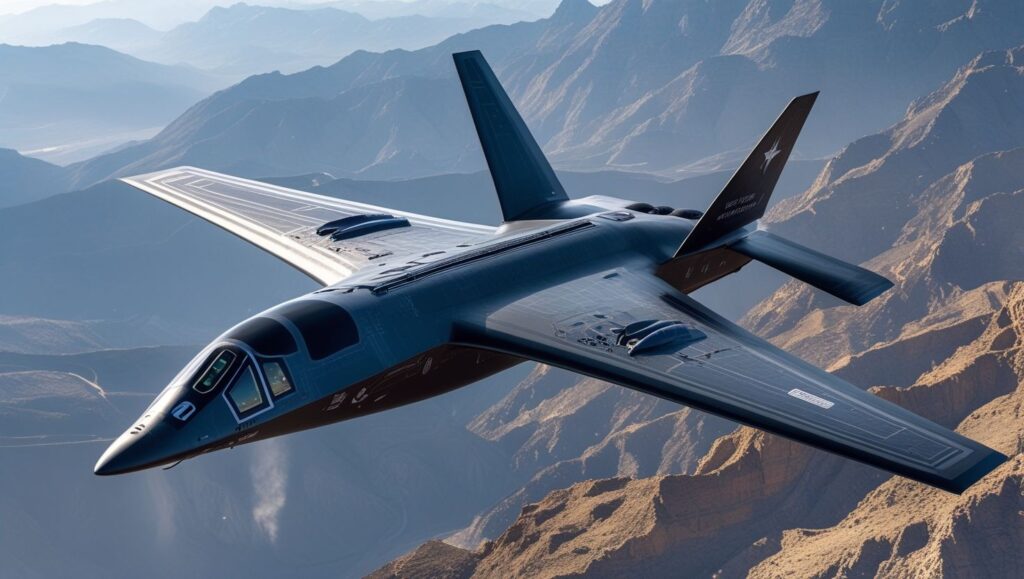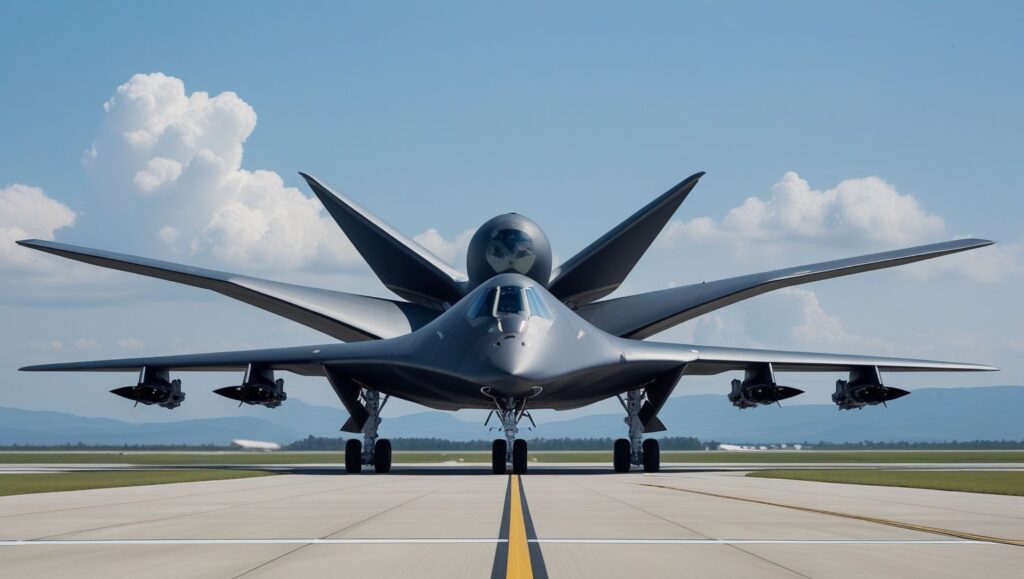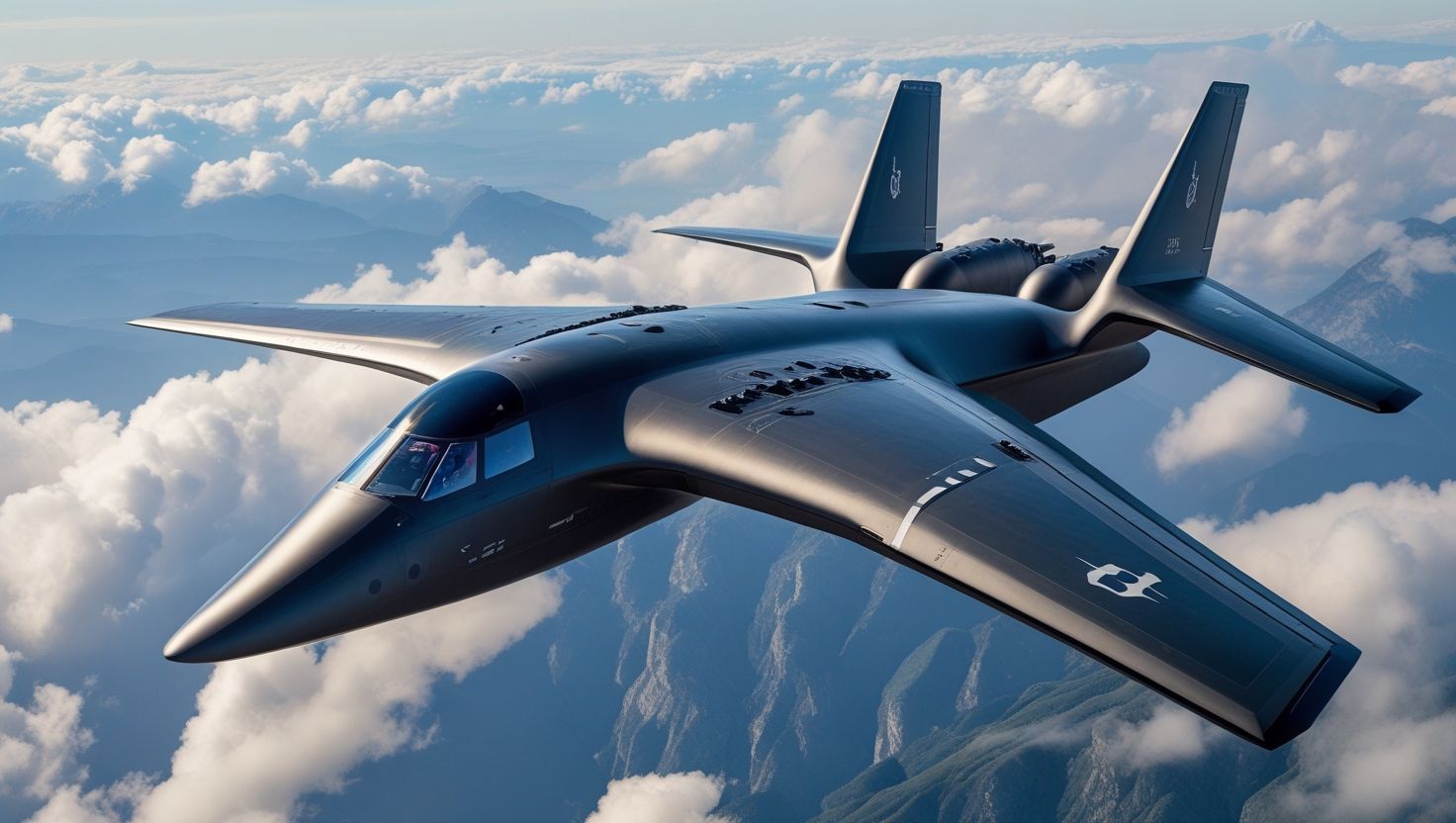Introduction
The Northrop B-2 Spirit: Science and Technology, The Northrop B-2 Spirit, also known as the “Stealth Bomber,” is one of the most iconic advancements in modern aviation. Developed by Northrop Grumman, this long-range, stealth heavy bomber designed for the United States Air Force. First unveiled publicly in 1988 and entering operational service in the 1990s, the B-2 was a significant leap in aviation and defense technologies. Unlike traditional bombers, its primary innovation lies in its radar-evading stealth capabilities, allowing it to penetrate dense anti-aircraft defenses without detection.
Built during the Cold War, its mission was to ensure the United States could maintain nuclear deterrence. Today, it is still in service and can carry both conventional and nuclear payloads. The B-2’s unique flying wing design, cutting-edge composite materials, and sophisticated avionics systems set it apart. While its cost—around $2 billion per unit—makes it one of the most expensive aircraft ever built, its strategic value is unparalleled. As nations invest in advanced aerial technology, the B-2 remains a case study in the blend of science, technology, and strategic military planning.
Stealth Technology: Invisible Warfare
One of the most revolutionary aspects of the B-2 Spirit is its stealth technology. This feature allows it to avoid detection by enemy radar systems, making it an invaluable asset for deep penetration missions into hostile territory. The aircraft achieves stealth through multiple means: shape, materials, and heat signature reduction. Its smooth, curved surfaces deflect radar waves instead of reflecting them back, and the absence of vertical stabilizers eliminates radar “echoes.” The B-2’s flying wing design is particularly effective for reducing its radar cross-section (RCS).
The materials used in its construction also play a key role. Radar-absorbent materials (RAM), which coat the aircraft’s surface, are engineered to absorb electromagnetic waves rather than reflect them. Furthermore, heat emitted from the engines managed through an intricate exhaust system to reduce infrared visibility. These combined technologies enable the B-2 to enter and exit enemy airspace undetected, conduct precision bombing, and return safely.
The science of stealth is a continual race between detection and evasion. While newer radar systems developed, the B-2’s adaptability and technological upgrades ensure it remains a step ahead in the invisible warfare paradigm.
Aerodynamic Design and Flying Wing Concept
The B-2 Spirit’s most distinguishing feature is its flying wing design, which lacks a conventional fuselage or tail. This shape is not only key to its stealth capabilities but also contributes to its aerodynamic efficiency. The flying wing structure allows for reduced drag and increased lift, resulting in better fuel efficiency and range—critical factors for long-range bombing missions.
Northrop engineers capitalized on the concept first developed in the 1940s by Jack Northrop. The lack of tail surfaces minimizes the aircraft’s radar signature, and the entire structure contributes to flight control through a network of elevons and split rudders embedded within the wing itself. This makes the B-2 one of the few aircraft capable of stable flight without traditional tail components.
Computer-aided design (CAD) and wind tunnel testing played vital roles in refining the aerodynamic qualities of the B-2. Its computer-based flight control systems are constantly adjusting flight surfaces to maintain stability, a necessity due to its inherently unstable design. In essence, while the flying wing was once considered impractical, modern science and technology turned it into a highly efficient and stealthy war machine.

Avionics and Navigation Systems
The Northrop B-2 Spirit: Science and Technology, The B-2 Spirit boasts some of the most advanced avionics and navigation systems in military aviation. These systems are vital for the execution of precision bombing missions deep within enemy territory, often without external support. The aircraft’s navigation guided by a highly accurate Inertial Navigation System (INS) coupled with a Global Positioning System (GPS). Together, these allow the B-2 to pinpoint its location and target with extreme accuracy—even in GPS-jammed environments.
Avionics also include radar systems that are tightly integrated with its stealth features. The radar operates on low-probability-of-intercept (LPI) principles, meaning it emits minimal signals that are hard to detect by adversaries. Its terrain-following radar helps it fly at low altitudes, avoiding detection and improving strike precision.
Additionally, the B-2 includes satellite communication systems for real-time data exchange, target updates, and command execution. Its onboard computers can be reprogrammed mid-flight, making it a highly dynamic platform. The B-2’s integration of stealth with sophisticated avionics has set the standard for future combat aircraft, embodying a seamless union between hardware, software, and operational doctrine.
Materials and Composite Construction
To ensure its stealth performance and durability, the B-2 Spirit is built using advanced materials and composites that go far beyond traditional aerospace engineering. Much of the airframe is constructed from carbon-fiber-reinforced polymer (CFRP), a strong yet lightweight material that also has radar-absorbing properties. These composites allow for a reduction in overall weight, increasing range and payload capabilities.
A key feature is the use of Radar-Absorbent Material (RAM) coatings that cover the aircraft’s surface. These materials engineered at the molecular level to absorb and dissipate radar energy. Maintenance of this coating is meticulous, as any imperfection can compromise the aircraft’s stealth.
Engineers also focused on thermal resistance and electromagnetic shielding. The B-2’s skin designed to withstand various environmental stressors while maintaining radar invisibility. For instance, special materials are used around the exhaust systems to minimize the aircraft’s infrared signature.
The science of composite materials continues to evolve, and the B-2 remains a prime example of how cutting-edge material science can contribute to national defense. With ongoing updates, the aircraft expected to maintain operational readiness well into the 2030s.
Weaponry and Payload Systems
Despite its sleek, stealth-focused appearance, the B-2 Spirit is a powerful combat machine capable of carrying a massive range of weaponry. Its internal weapons bays allow it to carry up to 40,000 pounds of ordnance, all while maintaining its stealth profile. The B-2 can be armed with both conventional and nuclear weapons, making it a central pillar in the U.S. strategic deterrent force.
The aircraft supports a variety of bomb types, including the Joint Direct Attack Munition (JDAM), precision-guided bombs, and the Massive Ordnance Penetrator (MOP), designed to destroy deeply buried targets. When carrying nuclear payloads, it uses the B61 and B83 thermonuclear bombs, and it icertified for delivery under the Single Integrated Operational Plan (SIOP).
Weapon delivery assisted its precision guidance systems and onboard computers, which can alter targeting mid-mission. The B-2’s weapon bays also feature rotating racks for efficient deployment. Through these features, the B-2 maintains its role as a highly versatile and deadly component of the U.S. Air Force’s global strike capabilities, balancing scientific innovation with military necessity.
Maintenance and Operational Challenges
The Northrop B-2 Spirit: Science and Technology, Operating the B-2 Spirit involves a complex web of maintenance procedures and logistical support systems. Its stealth technology, while groundbreaking, is also demanding to maintain. Special climate-controlled hangars, known as “Dock Shelters,” required to preserve its delicate RAM coatings. Even minor damage or wear to its radar-absorbing skin can compromise the aircraft’s stealth.
Each B-2 mission involves extensive pre- and post-flight inspections. Technicians must meticulously check and sometimes reapply RAM coatings. Moreover, the aircraft’s systems require regular calibration, including its avionics, flight controls, and weapons systems.
Fueling the aircraft is another critical operation. The B-2 can refuel mid-air, but doing so requires precise coordination and trained aerial refueling crews. The B-2 also has one of the highest maintenance-to-flight-hour ratios in the U.S. Air Force—often requiring over 50 hours of maintenance for each hour of flight.
Despite these challenges, the operational success rate of the B-2 remains high due to constant improvements in maintenance technology, training, and remote diagnostics. These aspects reflect the aircraft’s high-tech nature and the extensive support infrastructure that sustains it.
Strategic Impact and Global Deterrence
The B-2 Spirit is not just a piece of advanced machinery—it is a strategic symbol of power and deterrence. Its ability to strike anywhere in the world within hours gives the United States a significant advantage in both conventional and nuclear deterrence strategies. The aircraft has been deployed in major operations such as Operation Allied Force in Kosovo, Operation Enduring Freedom in Afghanistan, and Operation Iraqi Freedom.
The B-2’s stealth allows it to carry out precision strikes without alerting adversaries, thereby minimizing civilian casualties and collateral damage. Its presence in a military operation can serve as a psychological deterrent, signaling overwhelming technological superiority.
As part of the U.S. nuclear triad, the B-2 fills the role of an airborne leg—offering flexibility and recallability that ground-based ICBMs or submarine-launched ballistic missiles do not. It ensures second-strike capability in the event of a nuclear conflict, reinforcing the concept of Mutually Assured Destruction (MAD).
In geopolitical terms, the B-2 is not just a bomber—it’s a diplomatic and strategic asset. Its very existence shapes military planning and foreign policy around the world, particularly in regions marked by instability or potential conflict.

Future Developments and Legacy
As the world of military aviation evolves, so too does the B-2 Spirit. Although only 21 units were built (with fewer operational today), the aircraft is still receiving upgrades to extend its service life. These include improved communications systems, radar enhancements, and more efficient computing capabilities.
However, the B-2’s eventual successor—the B-21 Raider—is already under development, aiming to incorporate next-generation stealth, AI integration, and unmanned flight capabilities. The B-21 will draw heavily on lessons learned from the B-2 while offering enhanced cost-effectiveness and reduced maintenance complexity.
Despite its eventual retirement, the B-2’s influence on aircraft design and military strategy will endure. It was among the first to successfully integrate stealth with long-range strike capacity, and its principles continue to guide modern aerospace engineering.
In the broader context of defense science and technology, the B-2 remains a milestone. It represents what is possible when visionary design, cutting-edge materials, and strategic foresight come together. Its legacy is not just in its missions—but in the scientific progress it inspired across the globe.
Conclusion:
The Northrop B-2 Spirit: Science and Technology, The Northrop B-2 Spirit stands as one of the most iconic representations of modern scientific achievement in aerospace and defense. It redefined the boundaries of what an aircraft could do—merging stealth, firepower, and advanced computing into a single, seamless platform. Through its aerodynamic design, composite materials, sophisticated avionics, and stealth capabilities, it continues to push the envelope of technology decades after its first flight.
The aircraft is not merely a machine of war; it is a symbol of national power, scientific ingenuity, and the strategic importance of air dominance. Its role in global deterrence, precision warfare, and technological advancement cannot be overstated. Even as it prepares to hand over the reins to newer platforms like the B-21 Raider, the B-2’s impact will be studied and celebrated for generations to come.
Whether viewed through the lens of engineering marvel or strategic necessity, the B-2 Spirit remains an unparalleled fusion of science and technology—truly a ghost in the skies.

zyj2xi
Some times its a pain in the ass to read what blog owners wrote but this site is very user pleasant! .
9vesat
What¦s Taking place i am new to this, I stumbled upon this I’ve found It absolutely helpful and it has aided me out loads. I’m hoping to give a contribution & help other customers like its helped me. Great job.
Hello! I’m at work browsing your blog from my new iphone 3gs! Just wanted to say I love reading your blog and look forward to all your posts! Carry on the fantastic work!
I have been exploring for a bit for any high-quality articles or blog posts on this sort of area . Exploring in Yahoo I at last stumbled upon this site. Reading this information So i’m happy to convey that I have an incredibly good uncanny feeling I discovered exactly what I needed. I most certainly will make sure to do not forget this website and give it a glance regularly.
Keep up the superb piece of work, I read few posts on this site and I conceive that your web blog is really interesting and has got bands of good information.
Enjoyed studying this, very good stuff, appreciate it. “Curiosity killed the cat, but for a while I was a suspect.” by Steven Wright.
Thanks for another magnificent article. Where else could anybody get that type of info in such a perfect way of writing? I have a presentation next week, and I’m on the look for such information.
Hello my friend! I wish to say that this article is awesome, nice written and include approximately all vital infos. I’d like to see more posts like this.
It¦s really a cool and useful piece of info. I¦m satisfied that you shared this useful information with us. Please keep us informed like this. Thank you for sharing.
You are a very smart person!
F*ckin¦ tremendous issues here. I am very glad to peer your article. Thanks a lot and i am looking forward to contact you. Will you please drop me a mail?
I used to be recommended this website by means of my cousin. I am no longer certain whether this submit is written through him as no one else realize such unique approximately my problem. You are incredible! Thanks!
There is noticeably a bundle to know about this. I assume you made certain nice points in features also.
Ahaa, its pleasant dialogue on the toopic oof this paragraph herre at this weblog,
I have read all that, so now me also commenting
at this place. https://hallofgodsinglassi.wordpress.com/
Hi, i feel that i noticed you visited my site thus i got here to “return the choose”.I am attempting to to find things to improve my web site!I guess its ok to make use of a few of your ideas!!
It’s actually a great and useful piece of information. I am satisfied that you simply shared this helpful information with us. Please stay us informed like this. Thanks for sharing.
I was just searching for this information for some time. After six hours of continuous Googleing, finally I got it in your web site. I wonder what’s the lack of Google strategy that don’t rank this kind of informative websites in top of the list. Usually the top web sites are full of garbage.
Greetings! This is my first visit to your blog! We are a group of volunteers and starting a new project in a community in the same niche. Your blog provided us beneficial information to work on. You have done a wonderful job!
Hello. fantastic job. I did not expect this. This is a remarkable story. Thanks!